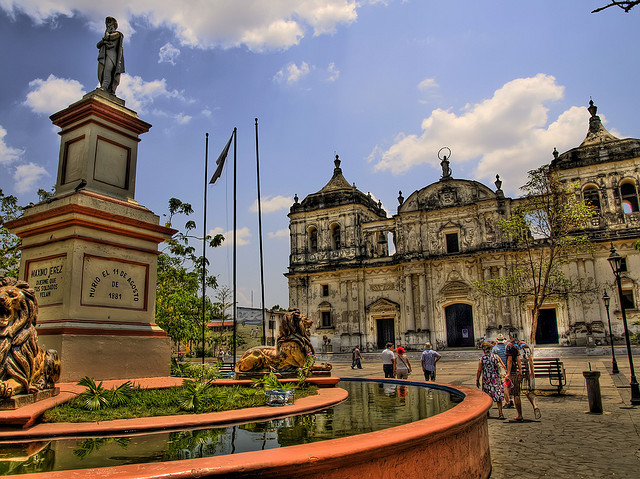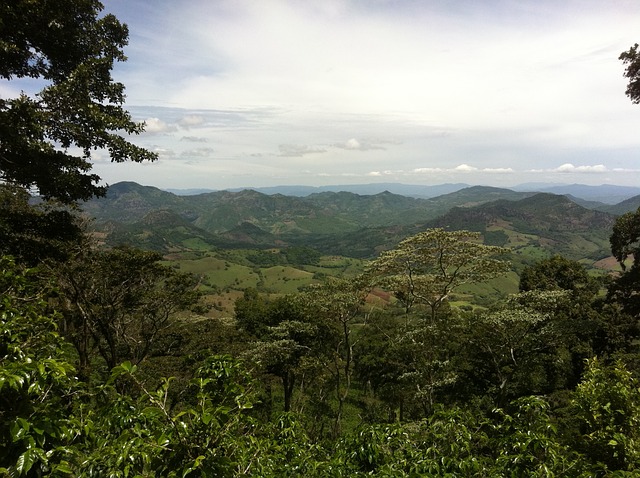Backpacking in Nicaragua
It is said of Nicaragua that the country has everything to offer in terms of tourism that a traveller, backpacker and globetrotter could wish for when visiting a country. Now, whether you should put this statement on the scales, or just be satisfied with the offered geographical and cultural spectacle, is up to you.
One thing is for sure: Nicaragua offers a multifaceted cultural diversity based on pre-Columbian influences, architecturally interesting styles from the colonial period and modern buildings. You will discover lonely dream beaches and be able to trek in high mountain regions, which often consist of active volcanoes. Let yourself be captivated by the engaging friendliness of the locals. We will show you what you can experience during a visit to Nicaragua and how you can travel cleverly through the country.
Experience Nicaragua
Nicaragua not only borders on the Caribbean and the Pacific, the country is also multi-ethnic and tropical. The best conditions to experience an adventurous and varied trip. Don’t let yourself be influenced by the stories about the country’s bloody past, but discover the country unbiased from its new side. The fact that it is now quite safe to travel to Nicaragua is proven by the fact that the country is increasingly becoming a popular emigration destination for American and European dropouts and pensioners. Everything is still cheap, so take the opportunity to explore the country extensively.
Nicaragua is divided into 15 departments and two autonomous regions. Numerous large rivers such as Posoltega, Telica, Chiquito and Izapa as well as lakes can be found in the interior, which all have their charms. Due to the warm tropical climate you will also find a rich flora and fauna, with jaguars, pumas, many snakes and mighty crocodiles. The variety of plants is also impressive, especially the shimmering orchids in all colours.
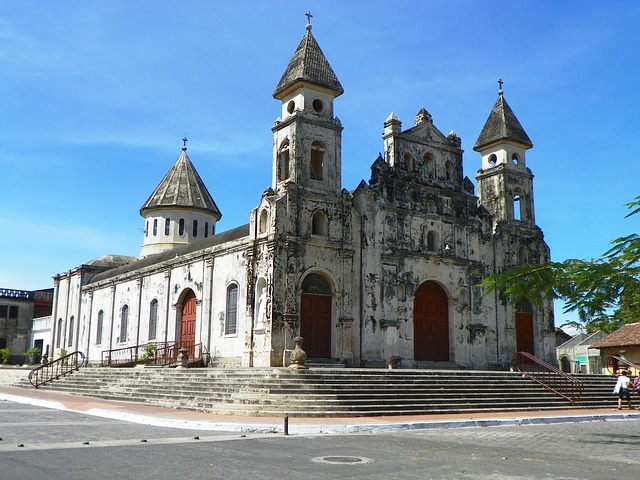
Backpacking in Nicaragua – Church
Visit the lively capital Managua, which according to Interpol and the United Nations is the safest capital in Central America. Visit the city of Granada, with its Victorian building elements, or relax at the Laguna de Apoyo. You’ll experience real Nicaragua flair in the tranquil fishing village of San Juan del Sur. Or you can plunge into the waves in Tola.
The village is considered to be the surf paradise of the region. No Nicaragua visit without visiting the volcanic island Ometepe with the two volcanoes Maderas and Concepción. At Maderas you can even visit coffee plantations. You can enjoy a dreamlike Caribbean flair in the island paradise Corn Islands, which consists of Big Corn Island and Little Corn Island. Don’t forget your diving goggles!
Tradition and culture in Nicaragua
Nicaragua, like most other Central American countries, is not a country with its own large indigenous population. Rather, the country is home to numerous indigenous tribes such as the Miskitos, Mayagnas and Ramas in the Caribbean region. In addition, there are the Garífunas from Africa and the Creole race formed over the centuries.
In the Pacific and in the centre and north of the country, you will encounter the Chorotegas, Cacaoperas, Nahoas and the Xiu-Sutiabas. The Chorotegas, for example, are a minority that has settled in Nicaragua, Costa Rica and Honduras. There are no more than 750 tribal members. All this naturally leads to a multi-layered culture that you can discover as you roam the country. The simple buildings made of palm trees and wood, which have been erected by the Chorotegas, among others, for centuries, are striking.
Although most of the old traditions are based on Catholic influences, much has mixed with indigenous cultures. Folklore is also an expression of the country’s extensive ethnic repertoire. Different dances, myths and art styles express the different cultures. The music is also multi-faceted. The songs are often accompanied by the marimba, a xylophone.
Backpacker Route in Nicaragua
Because of its geographical diversity and ancient indigenous culture, Nicaragua has a number of hot spots that stretch across the country. Nicaragua also has some exciting and adrenaline-pumping adventures in the dense jungles, fire-breathing volcanoes and rushing rivers. You’ll discover pre-Columbian architecture or be interested in post-colonial architectural structures.
Venture to fascinating volcanic islands or hang out on the dream beaches on the Pacific side or the Caribbean side. One as beautiful and charming as the other. You should get your tours exactly right. There is plenty to choose from. Everything depends on your wallet.
Nicaragua is a relatively unknown backpacker country. That doesn’t mean that nobody has been there yet, but it’s not quite as abandoned as many other countries in South or Central America. So I can only urge you to give Nicaragua a chance to discover.
Route 1: The classic (15-20 days)
- 1-2 days to get to know Managua, the capital of the country.
- 1 day Discover León with its impressive colonial architecture.
- 1 day visit Chinandega
- 1-2 days in Granada to visit the best preserved colonial old town in the country
- 3-4 days hanging out on Corn Island
- 3-4 days visiting volcanic island Omepete
- 1-2 days Laguna de Perlas
- 3 days to get to know Esteli, Matapalga and Tola
- 1 day exploring Bilwi
Route 2: Nicaragua all over (32-42 days)
- 1-2 days to get to know Managua, the capital of the country.
- 1 day Discover León with its impressive colonial architecture.
- 1 day visit Chinandega
- 1-2 days in Granada to visit the best preserved colonial old town in the country
- 3-4 days on Corn Island – Isla del Maíz – hang out
- 3-4 days visiting volcanic island Omepete
- 1-2 days Laguna de Perlas
- 3 days to get to know Esteli, Matapalga and Tola
- 1 day exploring Bilwi
- 2 days Mombache volcano
- 1 day El Castillo
- 2 days exploring barely visited Solentiname Islands island world
- 1 day Laguna de Apoyo
- 1 day volcano Masaya
- 1 day Reserva Silvestre Privada Montecristo
- 1 day Lagunaperla
- Enjoy 2 days harbour flair in Puerto Cabezas and Puerto Sandino.
- 2 days at the Miskito coast to get to know the Miskito indigenous people.
1 day visit the 6000 year old footprints of huellas de Acahualinca in the solidified volcanic ash on Lago en Managua (Nicaragua). - 1 day Gran Lago de Nicaragua
- 1 day Reserva Natural SelvaNegra in Matagalpa
- 3 days coffee route in Matagalpa
Travel times in Nicaragua
The climate in Nicaragua cannot be exactly defined because of the geographical diversity with large differences in altitude and the location. Roughly Nicaragua lies in the tropical zone. However, this does not mean that it is warm all year round. The different Pacific winds and the air currents from the Caribbean cause very different climate situations on the relatively small land area. On the Pacific side it is hot all year round. The rainy season extends from May to October. In June and July it can become quite dry and hot again for a short time. The Caribbean side is different. From November to April it is dry afterwards it comes to sporadic rain showers. In the lowlands it is mostly around 32 degrees. In the mountain regions on the other hand far less. A moderate climate prevails here.
Backpacker Budget in Nicaragua
Traveling is cheap in Nicaragua and also live, if you have European income. Just for comparison. The cost of living in Nicaragua is 60% of the US American cost. You don’t need heating and a lot of electricity to live there. Depending on your budget, you can expect costs of one to three euros for a meal. Beds cost between 3 and 7 euros in a hostel. Some destinations can only be reached by boat. There you can also go up with the prices. Of course, exclusivity has to be paid for.
Who wants a little more comfort and can afford it, looks around for the small family businesses, which call themselves “hospedajes”. Especially for couples, a double room for 15 euros a night is worthwhile. As already mentioned, you pay the food for little money. At the street stalls you are there with one Euro. Three to five times that amount will be spent in better small restaurants. The prices in Nicaragua according to Numeo are as follows:
- Menu in a simple restaurant 3 Euro
- Menu in the middle class restaurant 13 Euro
- ComboMeal in McDonalds 3 Euro
- Local beer (0.5 litres) 0,7 Euro
- Import beer (0.33 litres) 1.40 Euro
- Cappuccino (regular) 1.05 Euro
- Coke/Pepsi (0.33 litres) 0.80 Euro
- Water (0.33 litres) 0.50 Euro
Transport in Nicaragua
It is best to take a taxi, especially if you are travelling with several people. That’s safe and cheap. In the cities you pay a button and an egg for short distances. The longer distances between the cities, on the other hand, can be bridged with the bus lines that criss-cross the country. It’s faster with the expresso buses that don’t stop. Those who have more time and want to save some more cents take the Ordinario buses. Your budget is hardly burdened by the trips. Calculates times between 3 and 5 euro. You can book the international routes with www.ticabus.com or see what the bus companies Transnica and King Quality have to offer. Just Ticabus drives to all Central American countries.
- Single-Ticket Bus (local transport) 0.10 Euro
- Taxi Start (normal fare) 0.40 Euro
- Taxi 1km (normal rate) 0.40 Euro
- Taxi one hour (normal rate) 4.00 Euro
With it it can be lived. The so-called local Chicken busses drive also to favorable conditions from Managua to Guatemala city. Clever travelers get off at the border and then take a new local cheap bus on the other side. Pay attention to the annoying porters at the border. Negotiate the deal before, because otherwise the guys get quite uncomfortable and want outrageous prices. 20 dollars is not uncommon there. You can fly through the country with the local airline Commuter Airline, but it’s hardly worth it, because no route is more than 600 kilometers long.
Backpacker accommodation in Nicaragua
Backpackers who have a rather small budget on their trip should go straight to Nicaragua. There they can find a good place for relatively little money. There are also 5 star hotels and exclusive lodges in Nicaragua that fulfil every wish and offer every comfort, but these are rather the exception. More widespread are cheap private accommodations in the style of Bed and Breakfast and some hostels in the neuralgic points of the country. At some times you can get a bed in a dorm for as little as 5 euros. Sometimes even less. However, as you can see at Hostelworld, the average prices are not quite as cheap.
- Granada 8 Euro
- Managua 11 Euro
- San Juan DelSur 6 Euro
- Leon 6 Euro
- Ometepe Iceland 4 Euro
- Matagalpa 8 Euro
- Esteli 9 Euro
- Popoyo 8 Euro
There are even accommodations where you can rent a hammock for a button and an egg. For your own safety, you should always do this in a hostel or private accommodation in the garden and not on any beach. The bed and breakfast offers in Nicaragua are well worth considering. Especially if you are travelling together.
For 10 Eurog you can get a room in which there is sometimes even a TV. Calculate for a room in a B&B in Granada. But in Managua it can cost twice as much. A little cheaper are the rooms in San Juan Del Sur. Really cheap you can stay with 10 Euro in Leon. Of course, in Omepete you have to pay a little more with 20 Euro. But in Masaya it’s cheap again with 9 Euro.
Backpackers, who want to stay in Managua, usually end up in the Barrio Martha Quezada. But this quarter is no longer considered the safest. The crooks quickly realized that the backpacker scene loves to be here. Also the area around the Tica Bus Station is not exactly safe. Better you look for an accommodation in Metro Centro or in Colonia Centroamerica as well as in Caraterra Masaya.
Camping in Nicaragua
Camping is not unknown in Nicaragua. Even near the best spots you can often camp inexpensively and safely. The Miramar Surf Camp, for example, is well known. Also recommendable is LOOTB Camping at Playa Maderas. At San Juan del Sur you can camp near the Coco beach and the La Flor Natural Reserve.
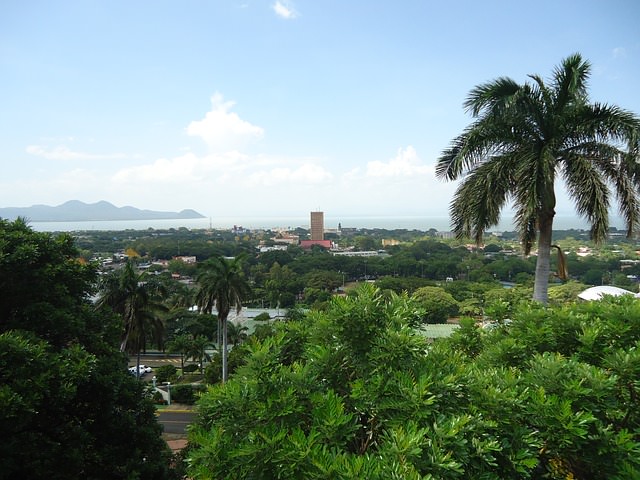
Backpacking in Nicaragua – managua
Backpacker Trips, Tips & Highlights in Nicaragua
Geographically, Nicaragua is divided into three regions, each with its own charm. Whether you want to visit the mighty volcanic chain in the interior or the Caribbean or Pacific side is up to you. Visit the old colonial Granada and take great photos of the fascinating architectural colonial buildings. At least as interesting is the old town of León. After all, the city was once the capital of the country. In San Sebastian you can participate in the festival of the same name every January in the exuberant festivities.
Wonderful white beaches await you in Bahía de San Juan del Sur over these watches over on a mountain the Cristo de la Misericordia statue. There you can also watch the fat baleen whales up close at the right time of year. Visit the La Reserva Natural Laguna de Apoyo, which stretches between the departments of Masaya and Granada. You are dealing with a freshwater lagoon that has formed in a volcanic crater.
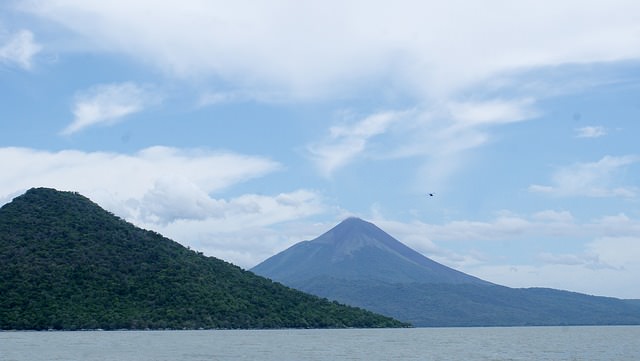
Backpacking in Nicaragua
Backpacker Highlights in Nicaragua
Not always only to the sea. In Nicaragua it is also worth visiting the many lakes. You can take a small kayak trip around the Las Isletas (islets) on the lake near the city of Granada. You can also explore the Lago Apoyo in the crater of the Apoyo volcano by kayak or just swim in the crystal clear water.
Climb up to Cerro Negro, which was formed after a volcanic eruption 150 years ago. You can climb up to 750 m. The Archipiélago de Solentiname is located in the extreme southeast of Lago Cocibolca. You can do island hopping in a gigantic freshwater lake. A trip to the 276 km2 large Ometepe island, which is also called Ōmetepētl – which means as much as: two mountains, in the language Náhuatl, is the absolute must during a Nicaragu visit. The volcano island, which consists of two volcanoes, lies in the Lago Cocibolca or also Gran Lago de Nicaragua.
Beach and Surfing in Nicaragua
After your tours it is worth hanging out in San Juan del Sur. There, the whole backpacker and surfer scene meets for a cheerful “Stell-dich-ein”. Especially spectacular is the magnificent chain of volcanoes in the hinterland. If you haven’t been on a surfboard before, you should try it here. It’s a bit calmer on Corn Island. Don’t forget your snorkeling equipment, the underwater world has it all. But you can also rent equipment on the spot.
Backpacker insider tips in Nicaragua
The volcano boarding offers a quite unusual leisure fun. Only in a few places in the world this is as possible as for example at the Cerro Negro. Either you dare to do it on your own or hire one during an organized tour. You can trek for example on the Isla de Ometepe or on the Mombacho volcano. Have you ever been to a witch village? If not, then go to the bewitched villages Diriomo and Diria near Masaya, where you will encounter the art of black magic everywhere.
In Masaya itself you will find artisan markets where you can buy great souvenirs. Dance and music on the open street are included. Watch the national bird Quetzal in the Reserva Natural Miraflor or enter the Cañón de Somoto gorge. Another little visited spot is the summit of Volcán La Pataste. But also the ascent to Volcán Cosigüina is rewarded with a spectacular view over the region. Have fun discovering and experiencing Nicaragua.
Food & Drinks in Nicaragua
Because of their high maize consumption and the use of grain in many dishes, Nicaraguans are also known as the “sons of maize”. Whether in liquid form like the traditional drinks Chicha and Pinolo or the hearty corn dishes in solid form like Nacatamal or Indio Viejo, corn is always the basis. The influences of the country’s cuisine, however, can be traced back to numerous waves of immigrants that flooded the country over the centuries. The culinary treasures from all over the world were then mixed with the indigenous recipes.
In addition to corn, red beans and rice are also a popular basis for local recipes. Everywhere you can try the cheap tortillas, which are offered with different fillings. A subspecies of the tortillas is Güirila from ground corn. Otherwise, beef, pork and fish are offered with the various dishes depending on the region. At the Atlantic coast there is for example Pescado (fish) fried, dried or in the soup. Also turtle eggs and their meat are offered. However, you should avoid this for reasons of species protection. The cuisine on the Pacific side is known for grilled meat, fried cheese or golden-brown baked tacos.
If you are a sweetmouth, try Atolillo and Perrereque. There’s no shortage of fruit in this tropical country either. You can pick delicious mangos, papayas or tamarind directly from the trees. Although there are regional differences in culinary preferences, you can enjoy the Gallo Pinto dish anywhere. Strangely enough, the basis for this is not corn, but rice. Beans, onions, Chiltoma (a kind of pepper) and Knobi are fried. Simply only good. Or simple and good.
Drinking in Nicaragua
Pinolillo is one of the national non-alcoholic drinks made from tropical fruits. Pinol de Iguana, Tibio, Tiste and Gofio are some of them. Cinnamon, sugar and sometimes egg yolk are part of the delicious drinks. La chicha is based on fermented maize. Later, a red dye is mixed in to give the drink a better visual effect. Of course beer is also available and rum is also enjoyed. Better you prefer the more expensive imported alcoholic drinks. Your head will thank you for it the next day.
Backpacker Visa and Vaccinations in Nicaragua
Entry regulations for German citizens with the known travel documents. Entry is possible for German citizens with the following documents:
- Passport: Yes
- Provisional passport: Yes
- Identity card: No
- Temporary identity card: No
- Children’s passport: Yes
Still valid child ID card according to old model (the child ID card has not been issued since 1 January 2006): Yes, with photo
Comments:
Travel documents must be valid for six months beyond the date of entry. A transit with a travel document as passport replacement is not possible. Children’s entries in a parent’s passport are no longer valid as of 26.06.2012. Each child needs its own identity document.
Visa
For tourist trips of up to 90 days no entry visa is required.
Vaccinations & medical advice
For direct entry from Germany, compulsory vaccinations are not required; for entry from a yellow fever area, proof of a valid yellow fever vaccination is required. This applies to all travellers from the age of one.
Dengue, malaria, leishmaniasis and leptospirosis are known in Nicaragua.

